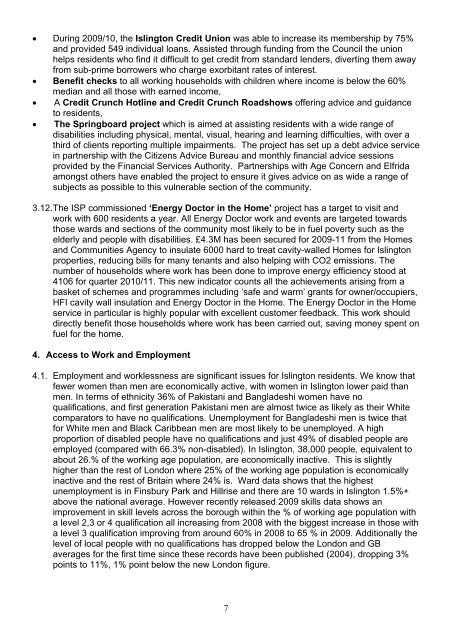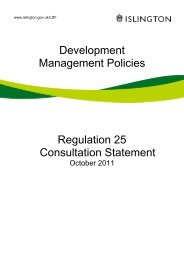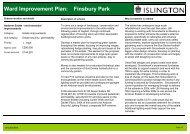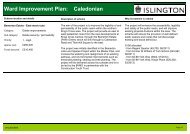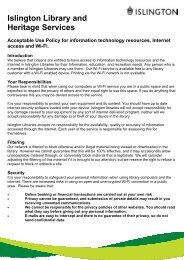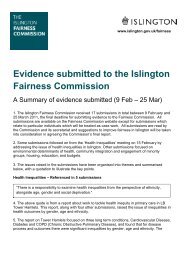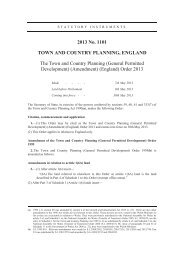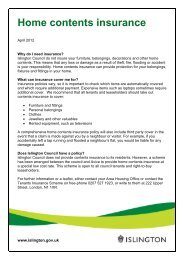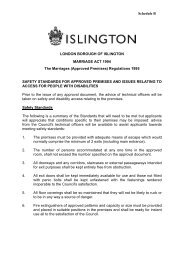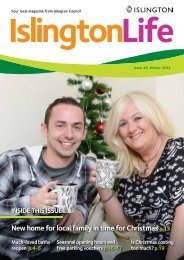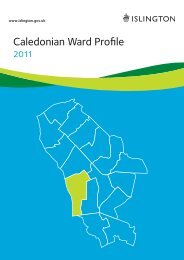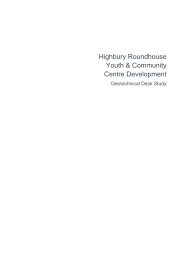Two Islingtons: Understanding the Problem - Islington Council
Two Islingtons: Understanding the Problem - Islington Council
Two Islingtons: Understanding the Problem - Islington Council
Create successful ePaper yourself
Turn your PDF publications into a flip-book with our unique Google optimized e-Paper software.
• During 2009/10, <strong>the</strong> <strong>Islington</strong> Credit Union was able to increase its membership by 75%<br />
and provided 549 individual loans. Assisted through funding from <strong>the</strong> <strong>Council</strong> <strong>the</strong> union<br />
helps residents who find it difficult to get credit from standard lenders, diverting <strong>the</strong>m away<br />
from sub-prime borrowers who charge exorbitant rates of interest.<br />
• Benefit checks to all working households with children where income is below <strong>the</strong> 60%<br />
median and all those with earned income,<br />
• A Credit Crunch Hotline and Credit Crunch Roadshows offering advice and guidance<br />
to residents,<br />
• The Springboard project which is aimed at assisting residents with a wide range of<br />
disabilities including physical, mental, visual, hearing and learning difficulties, with over a<br />
third of clients reporting multiple impairments. The project has set up a debt advice service<br />
in partnership with <strong>the</strong> Citizens Advice Bureau and monthly financial advice sessions<br />
provided by <strong>the</strong> Financial Services Authority. Partnerships with Age Concern and Elfrida<br />
amongst o<strong>the</strong>rs have enabled <strong>the</strong> project to ensure it gives advice on as wide a range of<br />
subjects as possible to this vulnerable section of <strong>the</strong> community.<br />
3.12. The ISP commissioned ‘Energy Doctor in <strong>the</strong> Home’ project has a target to visit and<br />
work with 600 residents a year. All Energy Doctor work and events are targeted towards<br />
those wards and sections of <strong>the</strong> community most likely to be in fuel poverty such as <strong>the</strong><br />
elderly and people with disabilities. £4.3M has been secured for 2009-11 from <strong>the</strong> Homes<br />
and Communities Agency to insulate 6000 hard to treat cavity-walled Homes for <strong>Islington</strong><br />
properties, reducing bills for many tenants and also helping with CO2 emissions. The<br />
number of households where work has been done to improve energy efficiency stood at<br />
4106 for quarter 2010/11. This new indicator counts all <strong>the</strong> achievements arising from a<br />
basket of schemes and programmes including ‘safe and warm’ grants for owner/occupiers,<br />
HFI cavity wall insulation and Energy Doctor in <strong>the</strong> Home. The Energy Doctor in <strong>the</strong> Home<br />
service in particular is highly popular with excellent customer feedback. This work should<br />
directly benefit those households where work has been carried out, saving money spent on<br />
fuel for <strong>the</strong> home.<br />
4. Access to Work and Employment<br />
4.1. Employment and worklessness are significant issues for <strong>Islington</strong> residents. We know that<br />
fewer women than men are economically active, with women in <strong>Islington</strong> lower paid than<br />
men. In terms of ethnicity 36% of Pakistani and Bangladeshi women have no<br />
qualifications, and first generation Pakistani men are almost twice as likely as <strong>the</strong>ir White<br />
comparators to have no qualifications. Unemployment for Bangladeshi men is twice that<br />
for White men and Black Caribbean men are most likely to be unemployed. A high<br />
proportion of disabled people have no qualifications and just 49% of disabled people are<br />
employed (compared with 66.3% non-disabled). In <strong>Islington</strong>, 38,000 people, equivalent to<br />
about 26.% of <strong>the</strong> working age population, are economically inactive. This is slightly<br />
higher than <strong>the</strong> rest of London where 25% of <strong>the</strong> working age population is economically<br />
inactive and <strong>the</strong> rest of Britain where 24% is. Ward data shows that <strong>the</strong> highest<br />
unemployment is in Finsbury Park and Hillrise and <strong>the</strong>re are 10 wards in <strong>Islington</strong> 1.5%+<br />
above <strong>the</strong> national average. However recently released 2009 skills data shows an<br />
improvement in skill levels across <strong>the</strong> borough within <strong>the</strong> % of working age population with<br />
a level 2,3 or 4 qualification all increasing from 2008 with <strong>the</strong> biggest increase in those with<br />
a level 3 qualification improving from around 60% in 2008 to 65 % in 2009. Additionally <strong>the</strong><br />
level of local people with no qualifications has dropped below <strong>the</strong> London and GB<br />
averages for <strong>the</strong> first time since <strong>the</strong>se records have been published (2004), dropping 3%<br />
points to 11%, 1% point below <strong>the</strong> new London figure.<br />
7


